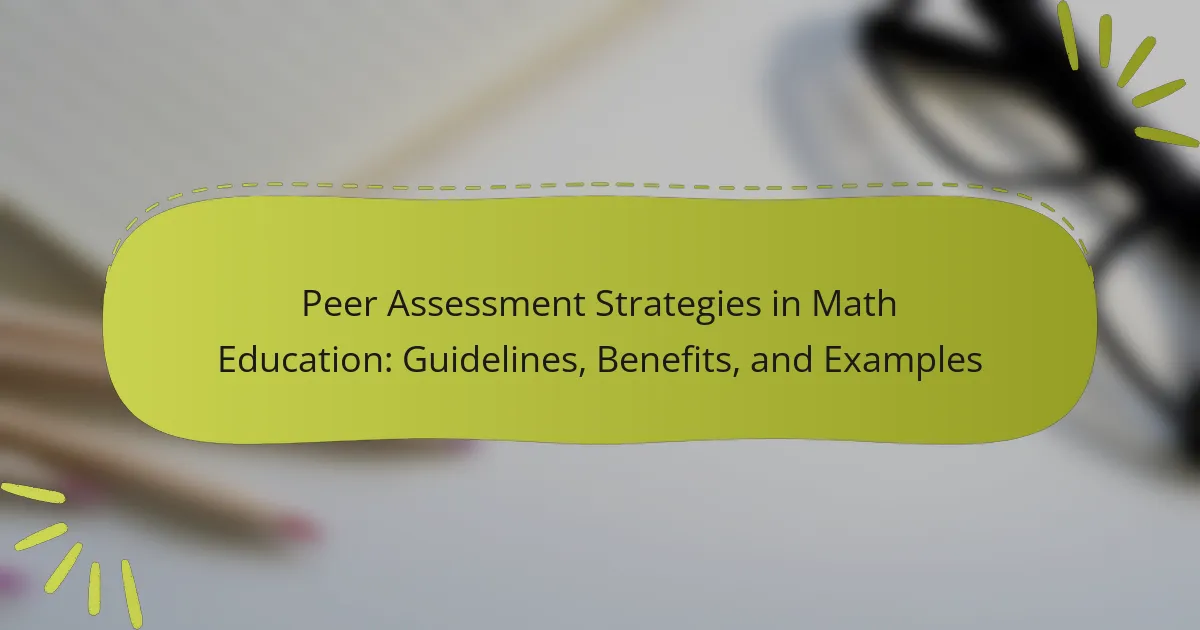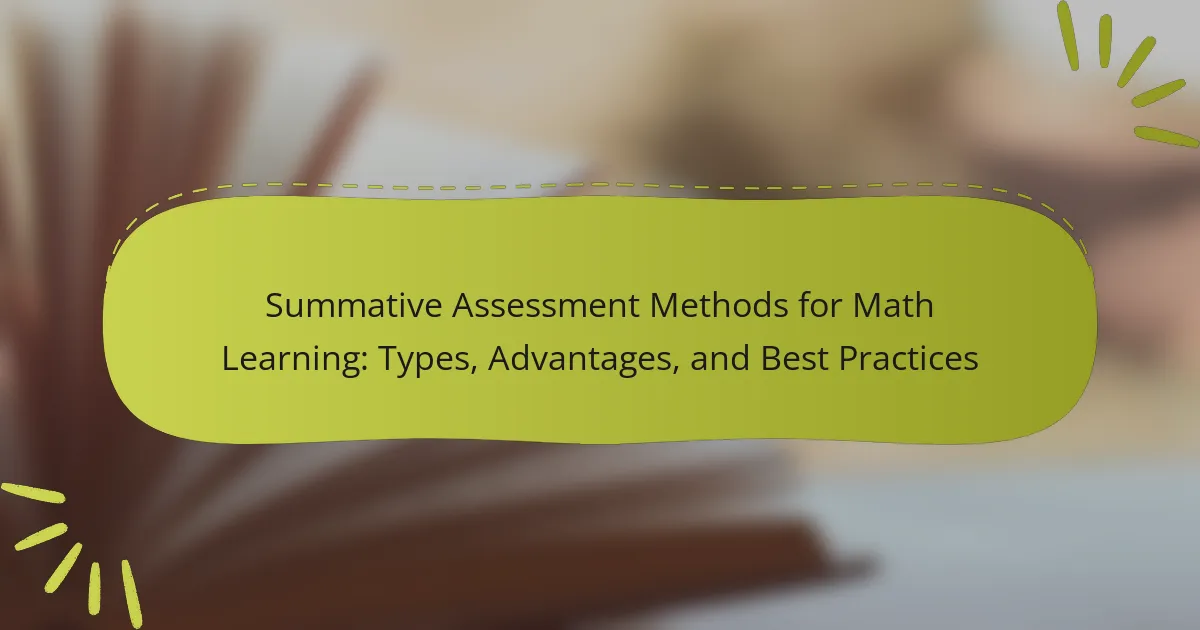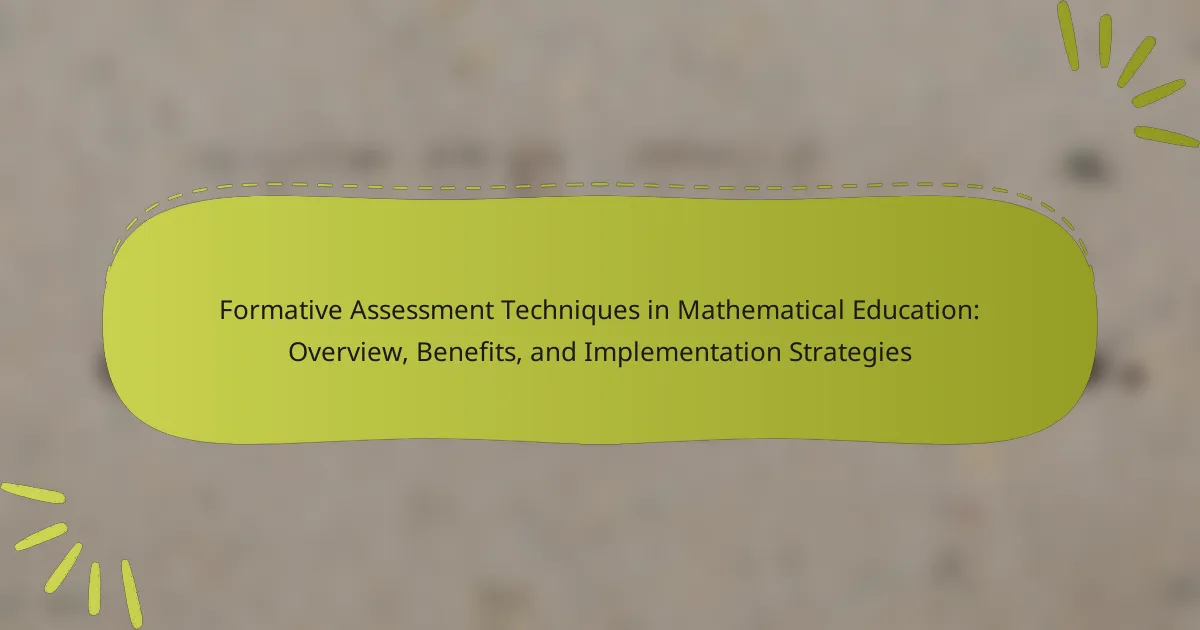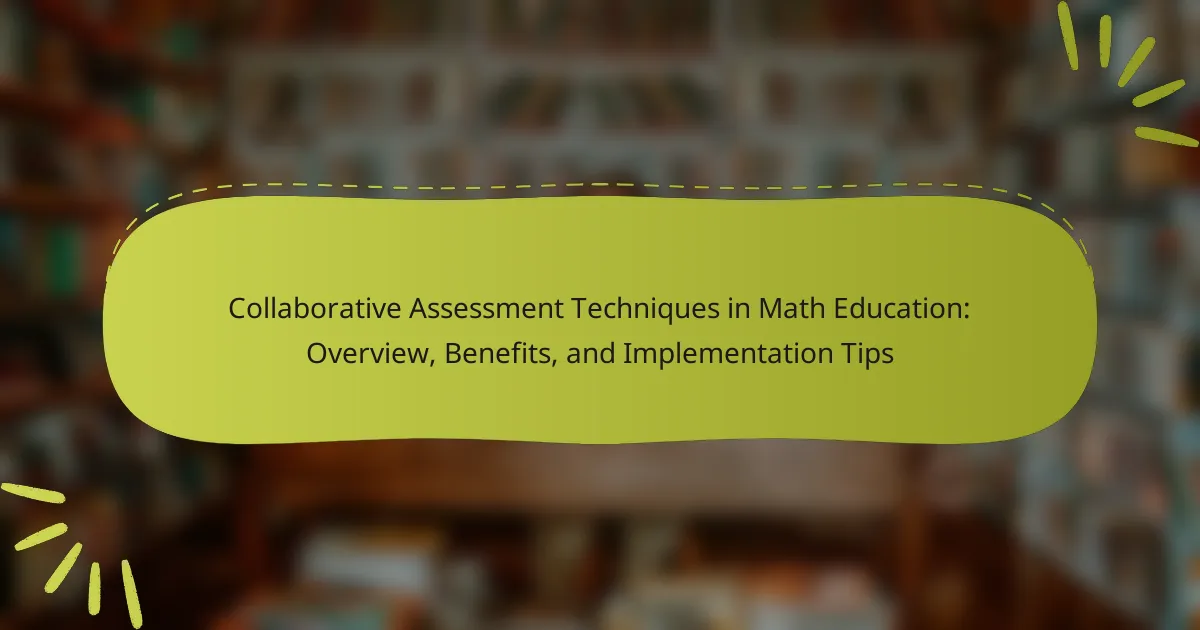Self-assessment in math learning is a process where students evaluate their own understanding and skills in mathematics, helping them identify strengths and weaknesses. This practice promotes active engagement with the material and enhances motivation, leading to improved academic performance. Techniques such as reflective journaling, quizzes, and peer evaluation facilitate self-assessment by providing feedback and encouraging collaboration. Additionally, reflection strategies enhance critical thinking and self-regulation skills, further supporting effective learning in mathematics. Overall, self-assessment serves as a valuable tool in math education, fostering deeper insights and better learning outcomes.
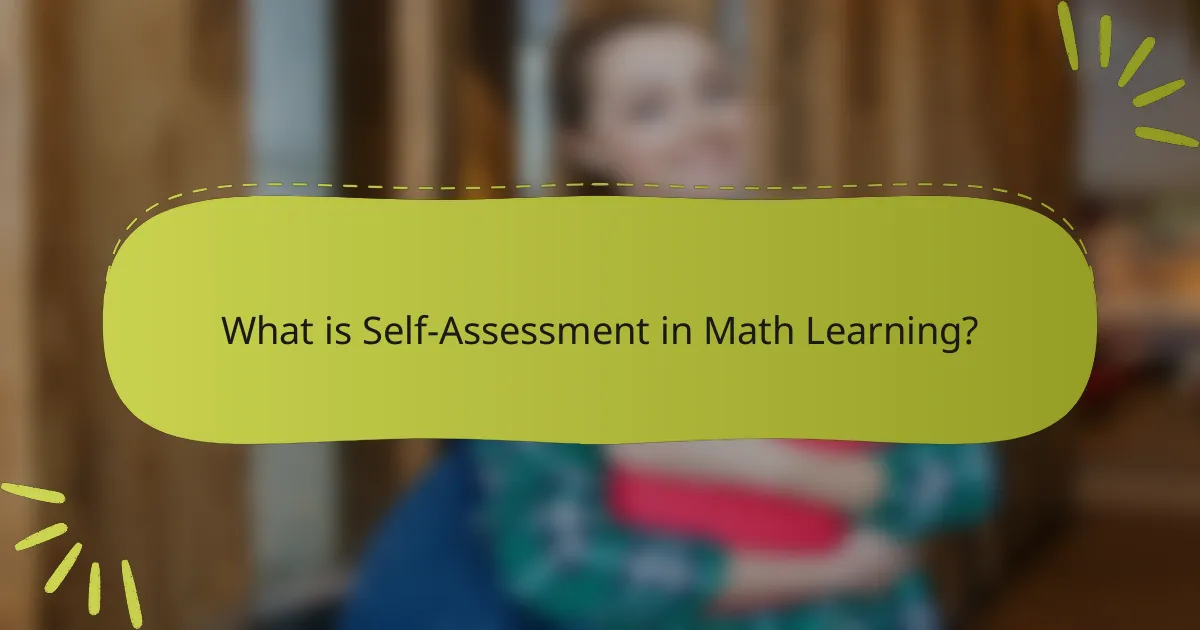
What is Self-Assessment in Math Learning?
Self-assessment in math learning is the process where students evaluate their own understanding and skills in mathematics. This evaluation helps learners identify their strengths and weaknesses. Self-assessment encourages reflection on one’s learning process. It promotes active engagement with the material. Research shows that self-assessment can enhance motivation and improve academic performance. Studies indicate that students who self-assess are more likely to take ownership of their learning. This method fosters critical thinking and self-regulation skills. Overall, self-assessment is a valuable tool in math education.
How does self-assessment enhance math learning?
Self-assessment enhances math learning by promoting metacognition and self-regulation. It encourages students to reflect on their understanding and identify areas for improvement. This process helps learners set specific goals for their math skills. Research shows that students who engage in self-assessment demonstrate higher achievement levels. A study by Nicol and Macfarlane-Dick (2006) found that self-assessment fosters deeper learning and engagement. By evaluating their own work, students develop critical thinking skills. This practice also increases their motivation and ownership of their learning. Overall, self-assessment leads to a more personalized and effective math learning experience.
What are the key components of self-assessment in math?
The key components of self-assessment in math include goal setting, reflection, and feedback. Goal setting involves identifying specific learning objectives. Reflection requires students to evaluate their understanding and performance. Feedback can be self-generated or peer-reviewed. These components help students recognize their strengths and areas for improvement. Research shows that self-assessment enhances metacognitive skills and academic performance. Studies indicate that students who engage in self-assessment can achieve higher levels of mastery in math.
How does self-assessment differ from traditional assessment methods?
Self-assessment involves individuals evaluating their own understanding and skills, while traditional assessment methods rely on external evaluators. Self-assessment promotes personal reflection and encourages ownership of learning. In contrast, traditional assessments often focus on standardized testing and grading by teachers. Research indicates that self-assessment can improve student motivation and engagement (Boud, 1995). Traditional assessments may not provide the same level of insight into a student’s thought process. Self-assessment fosters critical thinking skills. Traditional methods tend to emphasize memorization over understanding. Overall, self-assessment empowers learners to take charge of their educational journey.
Why is self-assessment important for math students?
Self-assessment is important for math students because it fosters independent learning and self-awareness. Math students who engage in self-assessment can identify their strengths and weaknesses. This process encourages them to take responsibility for their learning. Research shows that self-assessment leads to improved academic performance. A study by Nicol and Macfarlane-Dick (2006) found that students who self-assess develop better metacognitive skills. These skills enable them to reflect on their problem-solving strategies. Moreover, self-assessment promotes motivation and engagement in the learning process. Overall, self-assessment equips math students with essential skills for lifelong learning.
What benefits does self-assessment provide in understanding math concepts?
Self-assessment enhances understanding of math concepts by promoting active engagement and reflection. It allows learners to identify their strengths and weaknesses. This process fosters self-awareness regarding knowledge gaps. Research indicates that self-assessment can improve retention of mathematical concepts. A study by Nicol and Macfarlane-Dick (2006) found that students who self-assess show increased motivation and performance. Additionally, self-assessment encourages goal-setting and personalized learning strategies. This method leads to a deeper comprehension of mathematical principles. Overall, self-assessment is a valuable tool in math education.
How does self-assessment contribute to student motivation and confidence?
Self-assessment enhances student motivation and confidence by promoting self-awareness and ownership of learning. When students evaluate their own work, they identify strengths and areas for improvement. This process fosters a growth mindset, encouraging them to take on challenges. Research shows that self-assessment can lead to higher academic achievement. According to a study by Andrade and Valtcheva (2009), students who engage in self-assessment demonstrate increased motivation and self-efficacy. This is because they gain a clearer understanding of their progress. As students recognize their improvements, their confidence in their abilities grows. Ultimately, self-assessment empowers students to take charge of their learning journey.
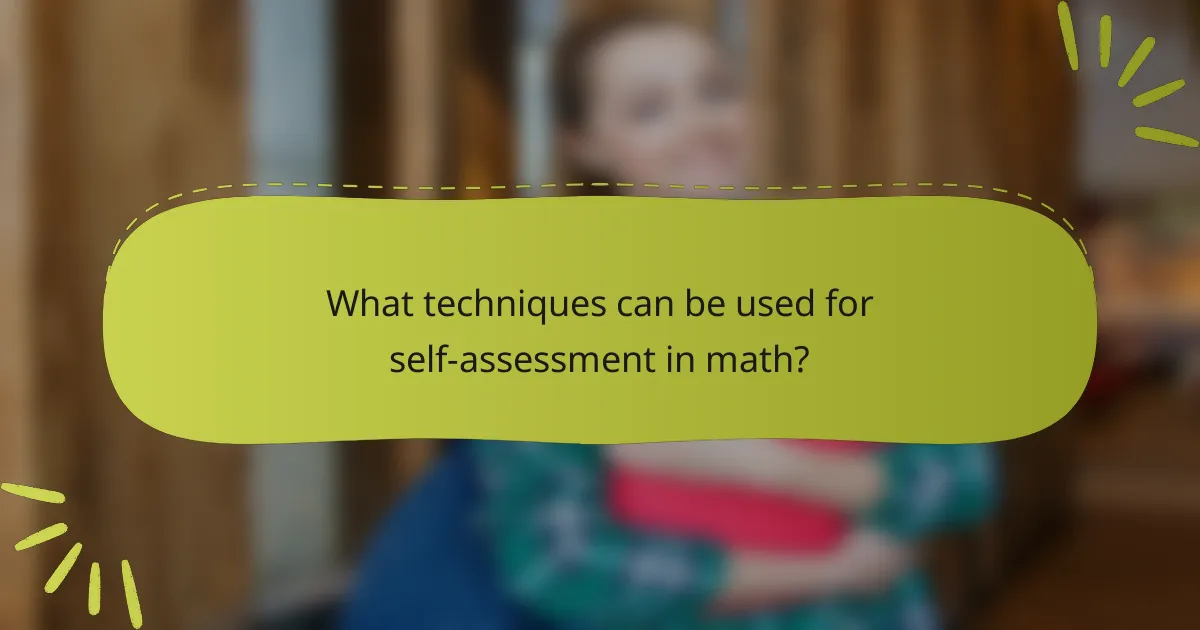
What techniques can be used for self-assessment in math?
Self-assessment in math can be conducted using techniques such as reflective journaling, quizzes, and peer evaluation. Reflective journaling allows students to record their thought processes and problem-solving strategies. Quizzes provide immediate feedback on understanding and skills. Peer evaluation encourages collaboration and insight from classmates. Additionally, self-checking work against answer keys helps verify accuracy. These techniques promote awareness of strengths and areas for improvement. Research shows that self-assessment enhances student engagement and learning outcomes.
How can students effectively implement self-assessment techniques?
Students can effectively implement self-assessment techniques by regularly reviewing their own work. They should compare their solutions to model answers or rubrics. This helps identify strengths and weaknesses in understanding. Setting specific goals for improvement is also crucial. Students can track their progress over time to see growth. Utilizing reflection journals can enhance self-awareness in learning. Engaging in peer assessments can provide additional perspectives. Research shows that self-assessment fosters greater academic independence and responsibility.
What are some common self-assessment tools and methods in math?
Common self-assessment tools and methods in math include quizzes, reflective journals, and rubrics. Quizzes allow learners to evaluate their understanding of mathematical concepts. Reflective journals enable students to track their learning progress and identify areas for improvement. Rubrics provide clear criteria for assessing performance on math tasks. Peer assessments can also be utilized, where students evaluate each other’s work. Self-assessment checklists are useful for students to monitor their skills. Additionally, online platforms often offer diagnostic tests to gauge proficiency. These tools promote self-awareness and guide learners in their math education.
How can rubrics enhance the self-assessment process in math learning?
Rubrics enhance the self-assessment process in math learning by providing clear criteria for evaluation. They outline specific expectations for student performance. This clarity helps learners understand their strengths and areas for improvement. Rubrics also encourage reflective thinking about one’s work. Students can compare their performance to the rubric criteria. This comparison promotes self-awareness in their learning journey. Research shows that rubrics can improve student motivation and engagement. A study by Andrade and Du (2005) found that students using rubrics performed better in self-assessment tasks. Overall, rubrics serve as a valuable tool in guiding students through the self-assessment process in math learning.
What role does feedback play in self-assessment?
Feedback is essential in self-assessment as it provides external validation of one’s performance. It helps individuals identify strengths and weaknesses in their understanding. Constructive feedback guides learners in setting realistic goals for improvement. Research indicates that feedback enhances self-reflection and critical thinking skills. According to Hattie and Timperley’s work on feedback, effective feedback can lead to significant learning gains. This underscores the importance of integrating feedback into the self-assessment process for better educational outcomes.
How can peers provide valuable feedback during self-assessment?
Peers can provide valuable feedback during self-assessment by offering diverse perspectives. This feedback helps individuals identify strengths and weaknesses they may overlook. Peers can also validate self-assessment results, enhancing confidence in one’s abilities. Constructive criticism from peers allows for targeted improvements in specific areas. Studies show that peer feedback increases engagement and motivation in learning environments. Research indicates that collaborative assessment fosters deeper understanding of content. Additionally, peer interactions can facilitate knowledge sharing and skill development. Overall, peer feedback enriches the self-assessment process in meaningful ways.
What strategies can teachers use to facilitate effective self-assessment feedback?
Teachers can use several strategies to facilitate effective self-assessment feedback. One effective strategy is to provide clear rubrics that outline expectations. These rubrics guide students in evaluating their own work accurately. Another strategy involves engaging students in reflective journaling. This encourages them to articulate their thought processes and learning experiences. Teachers can also implement peer assessment activities. This allows students to give and receive feedback from classmates, enhancing their understanding. Additionally, incorporating self-assessment checklists can help students monitor their progress. These tools provide a structured approach to self-evaluation. Regular feedback sessions with teachers can further support this process. These sessions allow for personalized guidance and clarification of misunderstandings. Research indicates that these strategies improve student self-awareness and learning outcomes.
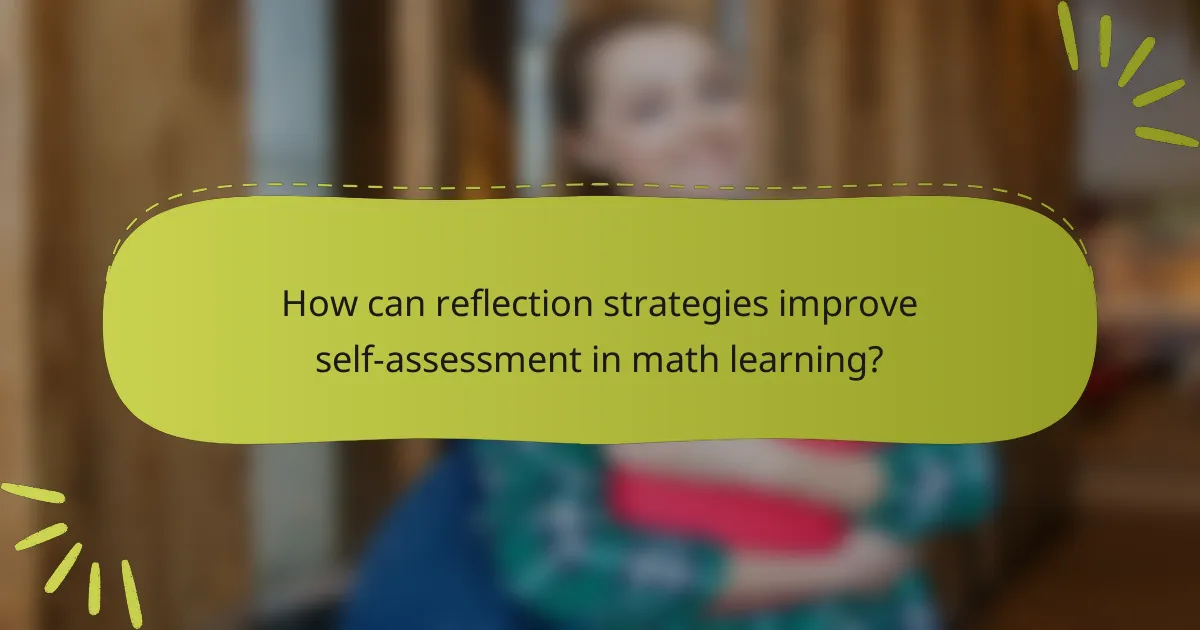
How can reflection strategies improve self-assessment in math learning?
Reflection strategies enhance self-assessment in math learning by encouraging students to evaluate their understanding. These strategies prompt learners to think critically about their problem-solving processes. They help identify strengths and weaknesses in mathematical concepts. For instance, reflective journaling allows students to document their thought processes and outcomes. This documentation can reveal patterns in their learning. Additionally, peer discussions foster collaborative reflection, leading to deeper insights. Research indicates that self-reflection improves metacognitive skills, which are crucial for effective learning. A study by Zimmerman (2002) highlights the positive impact of self-regulation on academic performance. Therefore, incorporating reflection strategies can significantly boost self-assessment in math education.
What are effective reflection strategies for math learners?
Effective reflection strategies for math learners include journaling, peer discussions, and self-questioning. Journaling allows learners to document their thought processes and problem-solving steps. This practice enhances understanding and retention of mathematical concepts. Peer discussions encourage collaboration and expose learners to different perspectives. Engaging with peers can clarify doubts and reinforce learning. Self-questioning prompts learners to evaluate their understanding and identify areas for improvement. Research shows that these strategies enhance metacognitive skills, leading to better performance in math. According to a study by Schunk and Zimmerman, self-reflection significantly impacts academic achievement.
How can journaling enhance the reflection process in math self-assessment?
Journaling enhances the reflection process in math self-assessment by providing a structured way to document thoughts and feelings. This practice encourages students to articulate their understanding of mathematical concepts. By writing about their problem-solving strategies, students can identify areas of strength and weakness. Journaling also fosters metacognition, allowing learners to evaluate their thought processes. Research indicates that reflective writing can improve academic performance. A study by Moon (2004) highlights that students who journal frequently show greater self-awareness in their learning. Thus, journaling serves as a valuable tool for deepening reflection in math self-assessment.
What questions should students ask themselves during reflection on their math learning?
Students should ask themselves questions that promote self-assessment in their math learning. Key questions include: What concepts did I understand well? What areas do I find challenging? How did I approach problem-solving? What strategies were effective for me? Did I seek help when needed? How can I improve my study habits? What resources helped me the most? Reflecting on these questions can enhance understanding and retention. Research indicates that self-reflection fosters deeper learning and critical thinking skills.
How can students track their progress through reflection?
Students can track their progress through reflection by regularly assessing their understanding and skills. This involves reviewing their completed assignments and tests to identify strengths and weaknesses. Reflecting on specific challenges faced during learning helps students recognize patterns in their performance. Keeping a journal or log of reflections can provide a clear record of progress over time. Engaging in self-questioning about what strategies worked or did not work enhances self-awareness. Research indicates that students who reflect on their learning show improved academic performance. For example, a study published in the Journal of Educational Psychology found that reflective practices significantly enhance student learning outcomes.
What tools can aid in tracking progress in math self-assessment?
Digital tools such as math apps and online platforms can aid in tracking progress in math self-assessment. These tools offer interactive exercises that provide immediate feedback. Examples include platforms like Khan Academy and IXL. They allow users to set goals and monitor their performance over time. Additionally, spreadsheet software can be used to log scores and track improvement. Paper-based methods like progress charts can also be effective. These methods help visualize growth in skills. Regular review of these tools reinforces learning and identifies areas needing improvement.
How does tracking progress contribute to long-term learning in math?
Tracking progress in math enhances long-term learning by providing measurable feedback on understanding. This feedback allows learners to identify strengths and weaknesses in their mathematical skills. Regularly monitoring progress encourages students to set specific goals. These goals can lead to increased motivation and engagement in the learning process. Research indicates that students who track their progress tend to retain information better. For example, a study by Hattie and Timperley (2007) found that feedback significantly influences learning outcomes. Thus, consistent progress tracking fosters a growth mindset and enhances overall mathematical proficiency.
What are some best practices for implementing self-assessment in math learning?
Best practices for implementing self-assessment in math learning include setting clear learning goals. Clear goals help students understand expectations. Providing rubrics can guide students in evaluating their work. Rubrics outline criteria for success, making assessment more objective. Encouraging reflective journaling allows students to articulate their understanding. Reflection promotes deeper learning and self-awareness. Regular check-ins help track progress over time. Consistent feedback supports students in identifying areas for improvement. Engaging students in peer assessments fosters collaboration and critical thinking. Peer assessments give students diverse perspectives on their work.
Self-assessment in math learning is the process through which students evaluate their own understanding and skills in mathematics, identifying strengths and weaknesses while promoting active engagement and reflection. This article covers the techniques for implementing self-assessment, including goal setting, reflective journaling, and peer evaluation, along with the benefits such as enhanced motivation, critical thinking, and improved academic performance. Additionally, it explores the role of feedback and reflection strategies in the self-assessment process, highlighting how these practices contribute to long-term learning and mastery of math concepts. Overall, self-assessment serves as a vital tool in fostering independent learning and self-awareness among math students.
